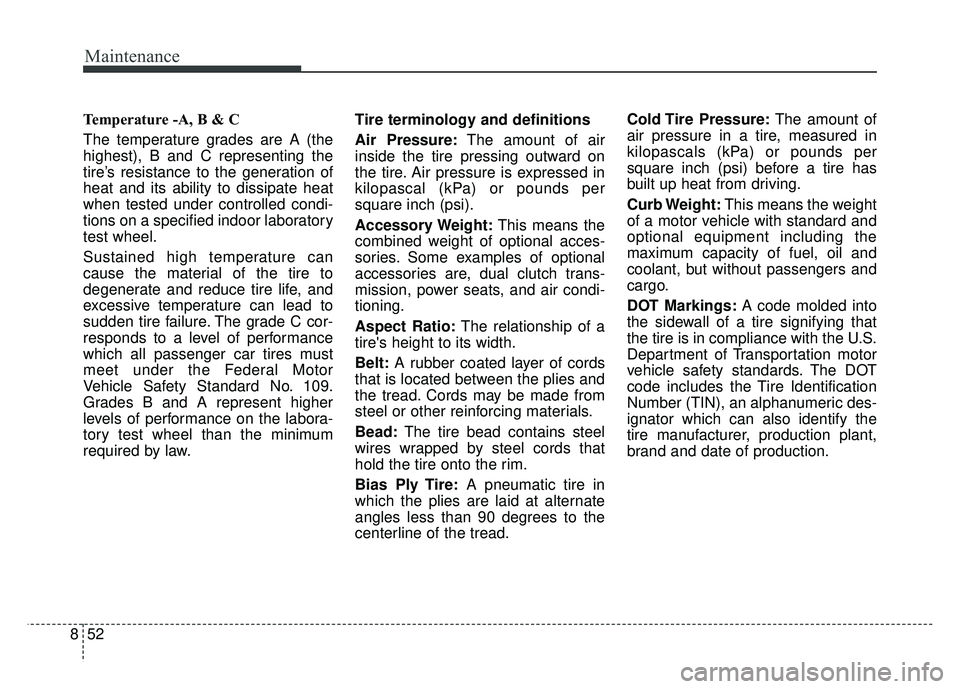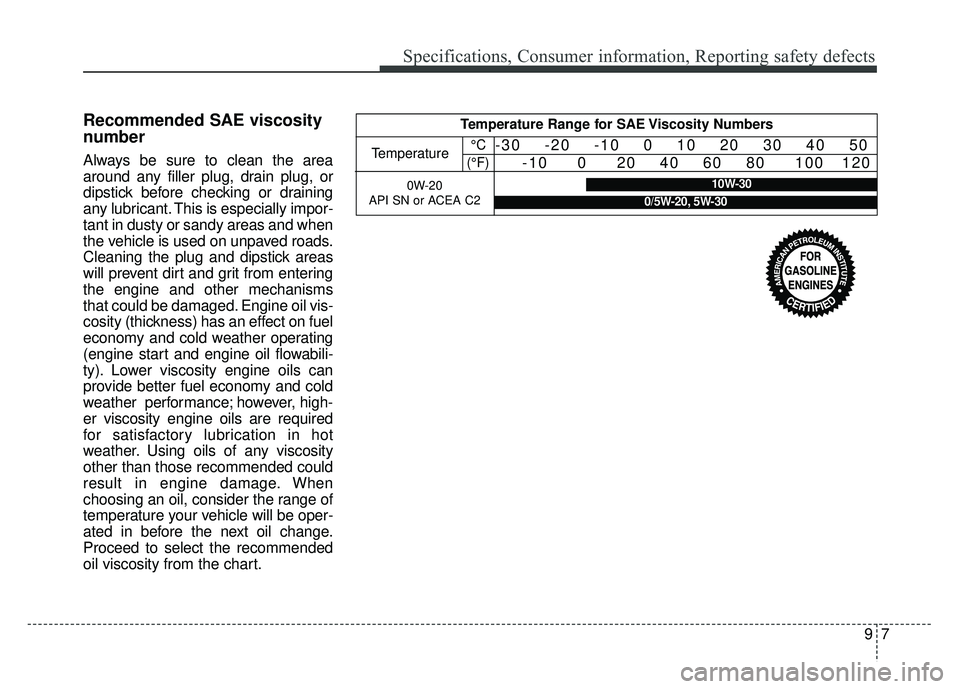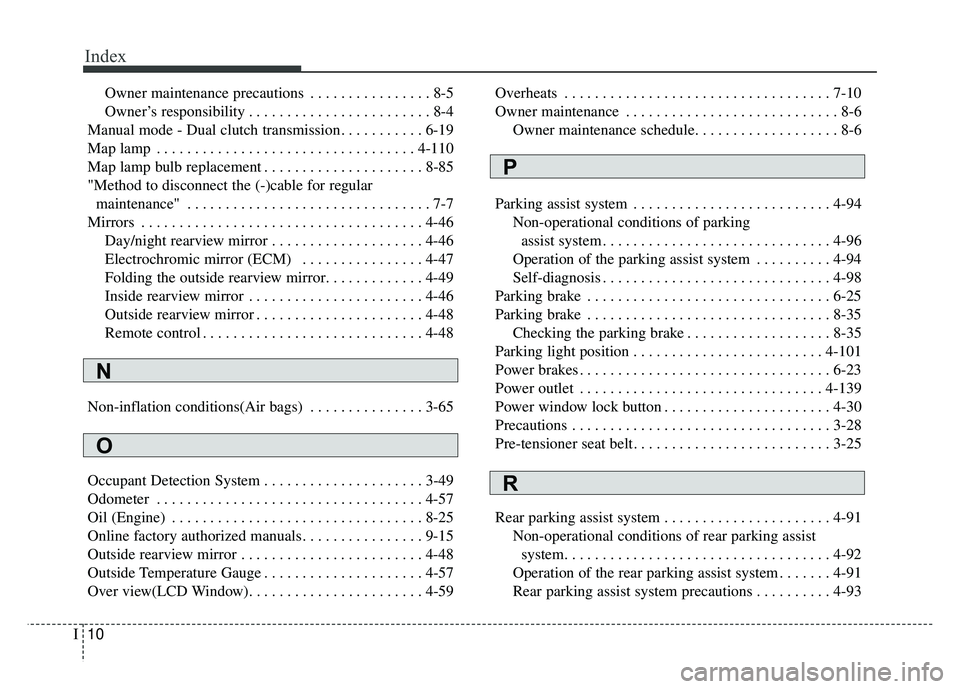oil temperature KIA NIRO 2017 Owners Manual
[x] Cancel search | Manufacturer: KIA, Model Year: 2017, Model line: NIRO, Model: KIA NIRO 2017Pages: 552, PDF Size: 14.92 MB
Page 375 of 552

687
Driving your vehicle
The use of chains may adverselyaffect vehicle handling.
Do not exceed 20 mph (30 km/h) or the chain manufacturer’s recom-
mended speed limit, whichever is
lower.
Drive carefully and avoid bumps, holes, sharp turns, and other road
hazards, which may cause the
vehicle to bounce.
Avoid sharp turns or locked-wheel braking.Use high quality ethylene gly-
col coolant
Your vehicle is delivered with high
quality ethylene glycol coolant in the
cooling system. It is the only type of
coolant that should be used because
it helps prevent corrosion in the cool-
ing system, lubricates the water
pump and prevents freezing. Be sure
to replace or replenish your coolant
in accordance with the maintenance
schedule in chapter 8. Before winter,
have your coolant tested to assure
that its freezing point is sufficient for
the temperatures anticipated during
the winter.
Check battery and cables
Winter puts additional burdens on
the battery system. Visually inspect
the battery and cables as described
in chapter 8. The level of charge in
your battery can be checked by an
authorized Kia dealer or a service
station.
Change to "winter weight" oil
if necessary
In some climates it is recommended
that a lower viscosity "winter weight"
oil be used during cold weather. See
chapter 9 for recommendations. If
you aren't sure what weight oil you
should use, consult an authorized
Kia dealer.
Check spark plugs and ignition
system
Inspect your spark plugs as
described in chapter 8 and replace
them if necessary. Also check all
ignition wiring and components to be
sure they are not cracked, worn or
damaged in any way.CAUTION- Snow chains
Chains that are the wrong size or improperly installed candamage your vehicle's brakelines, suspension, body andwheels.
Stop driving and retighten the chains any time you hear themhitting the vehicle.
Page 443 of 552

Maintenance
20
8
Maintenance Under Severe Usage Conditions
Severe Driving Conditions
A - Repeatedly driving short distance of less than 5 miles (8 km) in nor-
mal temperature or less than 10 miles (16 km) in freezing temperature
B - Extensive engine idling or low speed driving for long distances
C - Driving on rough, dusty, muddy, unpaved, graveled or salt- spread roads
D - Driving in areas using salt or other corrosive materials or in very cold weather E - Driving in heavy dust condition.
F - Driving in heavy traffic area.
G - Driving on uphill, downhill, or mountain roads repeatedly.
H - Towing a trailer or using a camper on roof rack.
I - Driving for patrol car, taxi, other commercial use of vehicle towing.
J - Driving over 106 mph (170 km/h).
K - Frequently driving in stop-and-go conditions.
The following items must be serviced more frequently on cars normally used under severe driving conditions. Refer
to the chart below for the appropriate maintenance intervals.
R : Replace I : Inspect and, after inspection, clean, adjust, repair or replace if neces\
sary
MAINTENANCE ITEMMAINTENANCE
OPERATIONMAINTENANCE INTERVALSDRIVING CONDITION
Engine oil and filter REvery 3,750 miles (6,000 km) or 6 monthsA, B, C, D, E, F, G,
H, I, J, K
Air cleaner filterRMore frequentlyC, E
Spark plugsRMore frequentlyB, H
Dual clutch transmission fluid REvery 75,000 miles (12,000 km)A, C, E, F, G, H, I, J
HSG (Hybrid Starter & Generator) beltREvery 30,000 miles (48,000 km) or 24 monthsC, D, E, K
IEvery 3,750 miles (6,000 km) or 6 monthsC, D, E, K
Front brake disc/pads, calipersIMore frequentlyC, D, G, H
Rear brake disc/padsIMore frequentlyC, D, G, F
Parking brakeIMore frequentlyC, D, G, H
Steering gear box, linkage & boots/lower arm ball
joint, upper arm ball jointIMore frequentlyC, D, E, F, G, H, I
Drive shafts and bootsIEvery 7,500 miles (12,000 km) or 6 monthsC, D, E, F, G, H, I, J
Climate control air filter
(for evaporator and blower unit)RMore frequentlyC, E
Suspension mounting boltsIMore frequentlyC, D, E, F, G, H, I
Page 475 of 552

Maintenance
52
8
Temperature -A, B & C
The temperature grades are A (the
highest), B and C representing the
tire’s resistance to the generation of
heat and its ability to dissipate heat
when tested under controlled condi-
tions on a specified indoor laboratory
test wheel.
Sustained high temperature can
cause the material of the tire to
degenerate and reduce tire life, and
excessive temperature can lead to
sudden tire failure. The grade C cor-
responds to a level of performance
which all passenger car tires must
meet under the Federal Motor
Vehicle Safety Standard No. 109.
Grades B and A represent higher
levels of performance on the labora-
tory test wheel than the minimum
required by law. Tire terminology and definitions
Air Pressure:
The amount of air
inside the tire pressing outward on
the tire. Air pressure is expressed in
kilopascal (kPa) or pounds per
square inch (psi).
Accessory Weight: This means the
combined weight of optional acces-
sories. Some examples of optional
accessories are, dual clutch trans-
mission, power seats, and air condi-
tioning.
Aspect Ratio: The relationship of a
tire's height to its width.
Belt: A rubber coated layer of cords
that is located between the plies and
the tread. Cords may be made from
steel or other reinforcing materials.
Bead: The tire bead contains steel
wires wrapped by steel cords that
hold the tire onto the rim.
Bias Ply Tire: A pneumatic tire in
which the plies are laid at alternate
angles less than 90 degrees to the
centerline of the tread. Cold Tire Pressure:
The amount of
air pressure in a tire, measured in
kilopascals (kPa) or pounds per
square inch (psi) before a tire has
built up heat from driving.
Curb Weight: This means the weight
of a motor vehicle with standard and
optional equipment including the
maximum capacity of fuel, oil and
coolant, but without passengers and
cargo.
DOT Markings: A code molded into
the sidewall of a tire signifying that
the tire is in compliance with the U.S.
Department of Transportation motor
vehicle safety standards. The DOT
code includes the Tire Identification
Number (TIN), an alphanumeric des-
ignator which can also identify the
tire manufacturer, production plant,
brand and date of production.
Page 529 of 552

97
Specifications, Consumer information, Reporting safety defects
Recommended SAE viscosity
number
Always be sure to clean the area
around any filler plug, drain plug, or
dipstick before checking or draining
any lubricant. This is especially impor-
tant in dusty or sandy areas and when
the vehicle is used on unpaved roads.
Cleaning the plug and dipstick areas
will prevent dirt and grit from entering
the engine and other mechanisms
that could be damaged. Engine oil vis-
cosity (thickness) has an effect on fuel
economy and cold weather operating
(engine start and engine oil flowabili-
ty). Lower viscosity engine oils can
provide better fuel economy and cold
weather performance; however, high-
er viscosity engine oils are required
for satisfactory lubrication in hot
weather. Using oils of any viscosity
other than those recommended could
result in engine damage. When
choosing an oil, consider the range of
temperature your vehicle will be oper-
ated in before the next oil change.
Proceed to select the recommended
oil viscosity from the chart.
Temperature Range for SAE Viscosity Numbers
Temperature°C
(°F)-30 -20 -10 0 10 20 30 40 50 -10 0 20 40 60 80 100 120
0W-20
API SN or ACEA C210W-30
0/5W-20, 5W-30
Page 547 of 552

Index
10I
Owner maintenance precautions . . . . . . . . . . . . . . . . 8-5
Owner’s responsibility . . . . . . . . . . . . . . . . . . . . . . . . 8-4
Manual mode - Dual clutch transmission . . . . . . . . . . . 6-19
Map lamp . . . . . . . . . . . . . . . . . . . . . . . . . . . . . . . . . . 4-11\
0
Map lamp bulb replacement . . . . . . . . . . . . . . . . . . . . . 8-85
"Method to disconnect the (-)cable for regular maintenance" . . . . . . . . . . . . . . . . . . . . . . . . . . . . . . . . 7-7
Mirrors . . . . . . . . . . . . . . . . . . . . . . . . . . . . . . . . . . . . \
. 4-46 Day/night rearview mirror . . . . . . . . . . . . . . . . . . . . 4-46
Electrochromic mirror (ECM) . . . . . . . . . . . . . . . . 4-47
Folding the outside rearview mirror. . . . . . . . . . . . . 4-49
Inside rearview mirror . . . . . . . . . . . . . . . . . . . . . . . 4-46
Outside rearview mirror . . . . . . . . . . . . . . . . . . . . . . 4-48
Remote control . . . . . . . . . . . . . . . . . . . . . . . . . . . . . 4-48
Non-inflation conditions(Air bags) . . . . . . . . . . . . . . . 3-65
Occupant Detection System . . . . . . . . . . . . . . . . . . . . . 3-49
Odometer . . . . . . . . . . . . . . . . . . . . . . . . . . . . . . . . . . . 4-\
57
Oil (Engine) . . . . . . . . . . . . . . . . . . . . . . . . . . . . . . . . . 8-25
Online factory authorized manuals . . . . . . . . . . . . . . . . 9-15
Outside rearview mirror . . . . . . . . . . . . . . . . . . . . . . . . 4-48
Outside Temperature Gauge . . . . . . . . . . . . . . . . . . . . . 4-57
Over view(LCD Window). . . . . . . . . . . . . . . . . . . . . . . 4-59 Overheats . . . . . . . . . . . . . . . . . . . . . . . . . . . . . . . . . . . 7-\
10
Owner maintenance . . . . . . . . . . . . . . . . . . . . . . . . . . . . 8-6
Owner maintenance schedule. . . . . . . . . . . . . . . . . . . 8-6
Parking assist system . . . . . . . . . . . . . . . . . . . . . . . . . . 4-94 Non-operational conditions of parkingassist system . . . . . . . . . . . . . . . . . . . . . . . . . . . . . . 4-96
Operation of the parking assist system . . . . . . . . . . 4-94
Self-diagnosis . . . . . . . . . . . . . . . . . . . . . . . . . . . . . . 4-98
Parking brake . . . . . . . . . . . . . . . . . . . . . . . . . . . . . . . . 6-25
Parking brake . . . . . . . . . . . . . . . . . . . . . . . . . . . . . . . . 8-35 Checking the parking brake . . . . . . . . . . . . . . . . . . . 8-35
Parking light position . . . . . . . . . . . . . . . . . . . . . . . . . 4-101
Power brakes . . . . . . . . . . . . . . . . . . . . . . . . . . . . . . . . . 6-23
Power outlet . . . . . . . . . . . . . . . . . . . . . . . . . . . . . . . . 4-139
Power window lock button . . . . . . . . . . . . . . . . . . . . . . 4-30
Precautions . . . . . . . . . . . . . . . . . . . . . . . . . . . . . . . . . . 3-28\
Pre-tensioner seat belt. . . . . . . . . . . . . . . . . . . . . . . . . . 3-25
Rear parking assist system . . . . . . . . . . . . . . . . . . . . . . 4-91 Non-operational conditions of rear parking assistsystem. . . . . . . . . . . . . . . . . . . . . . . . . . . . . . . . . . . 4-\
92
Operation of the rear parking assist system . . . . . . . 4-91
Rear parking assist system precautions . . . . . . . . . . 4-93
O
R
N
P